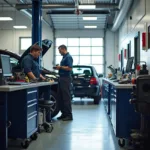Discovering a hole in your car bumper can be disheartening, but it’s a common issue with relatively simple solutions. Whether it’s from a minor fender bender or an unfortunate encounter with a rogue shopping cart, you don’t always need a costly trip to the auto body shop. This comprehensive guide will walk you through how to repair a hole in a plastic car bumper yourself, saving you both money and time.
Assessing the Damage: Size and Location Matter
Before diving into the repair, it’s crucial to assess the extent of the damage. The size and location of the hole will dictate the best course of action.
- Small Holes (less than 1 inch): These can often be filled using a specialized plastic bumper repair kit.
- Medium Holes (1-3 inches): A mesh patch or fiberglass cloth combined with a plastic filler can effectively bridge the gap.
- Large Holes (over 3 inches): May require professional intervention, especially if structural integrity is compromised.
The location of the hole also plays a vital role. Holes near edges or curved areas can be trickier to repair than those on flat surfaces.
Gathering Your Tools and Materials:
Having the right tools and materials is crucial for a successful repair. Here’s a checklist:
- Cleaning Supplies: Soap, water, wax and grease remover, microfiber cloths
- Sandpaper: 80-grit, 180-grit, 320-grit
- Masking Tape and Paper
- Plastic Bumper Repair Kit (for small holes)
- Fiberglass Cloth or Mesh Patch (for medium holes)
- Plastic Body Filler (Bondo or equivalent)
- Plastic Mixing Spreader
- Primer and Paint (color-matched to your bumper)
- Clear Coat
Step-by-Step Repair Process:
Follow these steps to repair a hole in your plastic car bumper:
1. Clean the Area: Thoroughly clean the damaged area and surrounding surfaces with soap and water. Use a wax and grease remover to ensure proper adhesion of repair materials.
2. Prepare the Surface: Use 80-grit sandpaper to roughen the area around the hole, creating a better bonding surface for the filler. Feather the edges outward to blend with the surrounding paint.
3. Mask Off the Area: Use masking tape and paper to protect the surrounding paintwork from filler and overspray during the painting process.
4. Repairing Small Holes:
- Clean the hole with a wax and grease remover.
- Follow the instructions provided with your chosen plastic bumper repair kit. These kits usually involve applying a specialized adhesive or filler to the hole.
- Allow the repair material to dry and harden completely before sanding smooth.
5. Repairing Medium Holes:
- Cut a piece of fiberglass cloth or mesh patch slightly larger than the hole.
- Mix a small batch of plastic body filler according to the manufacturer’s instructions.
- Apply a thin layer of filler to the back of the hole, ensuring it extends beyond the edges.
- Firmly press the fiberglass cloth or mesh patch onto the wet filler.
- Apply another layer of filler over the patch, smoothing it out with a spreader.
- Allow the filler to dry completely.
6. Sanding and Shaping:
- Once the filler is dry, use 80-grit sandpaper to shape the repaired area and blend it with the surrounding surface.
- Gradually work your way up to finer sandpaper grits (180-grit, then 320-grit) to achieve a smooth, even finish.
7. Priming and Painting:
- Clean the area thoroughly to remove any sanding dust.
- Apply several thin coats of primer, allowing each coat to dry before applying the next.
- Once the primer is dry, lightly sand it with 320-grit sandpaper for a smooth finish.
- Apply several thin coats of color-matched automotive paint, following the manufacturer’s instructions for drying times between coats.
8. Finishing Touches:
- After the paint has dried, apply 2-3 coats of clear coat to protect the paint and provide a glossy finish.
- Allow the clear coat to dry and cure completely before removing the masking tape.
Tips from a Pro:
“When repairing a plastic bumper, patience is key,” says John Smith, a seasoned auto body technician with over 20 years of experience. “Take your time with each step, especially sanding and painting, to achieve a professional-looking result.”
Frequently Asked Questions:
Q: Can I repair a cracked bumper using the same methods?
A: Yes, minor to moderate cracks can often be repaired using similar techniques as those outlined for holes.
Q: Is it necessary to use primer before painting?
A: Yes, primer promotes better paint adhesion and helps to create a uniform surface for the color coat.
Q: How long does it take for the filler to dry completely?
A: Drying times vary depending on the type of filler used and environmental conditions. Refer to the manufacturer’s instructions for specific drying times.
Need More Help?
For a visual guide on repairing car bumper paint scratches, check out our comprehensive article on car bumper paint scratch repair.
If you’re looking for professional car bumper repair services in Shirley, visit our page dedicated to car bumper repair shirley for reliable and affordable options.
Exploring Bumper Repair Options:
Wondering if your car bumper can be repaired? Find out more about the possibilities and limitations of car bumper repairs in our insightful article: can car bumper be repaired.
Get expert advice on how to repair the front bumper of your car with our step-by-step guide: how to repair front bumper of car.
Looking for a comprehensive car bumper repair kit? Explore our selection of high-quality car bumper repair packs designed for DIY enthusiasts.
Contact Us:
Need further assistance with your car repair needs? Reach out to our dedicated support team through WhatsApp: +1(641)206-8880 or email us at [email protected]. We’re available 24/7 to provide you with expert guidance and support.


